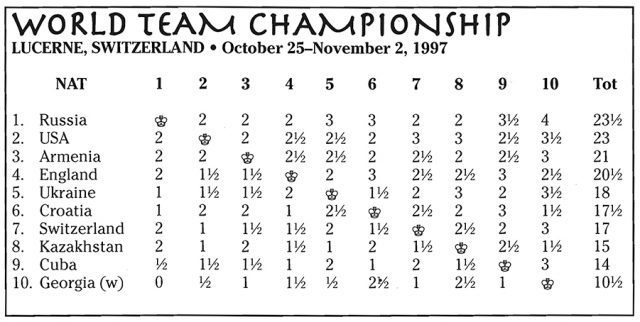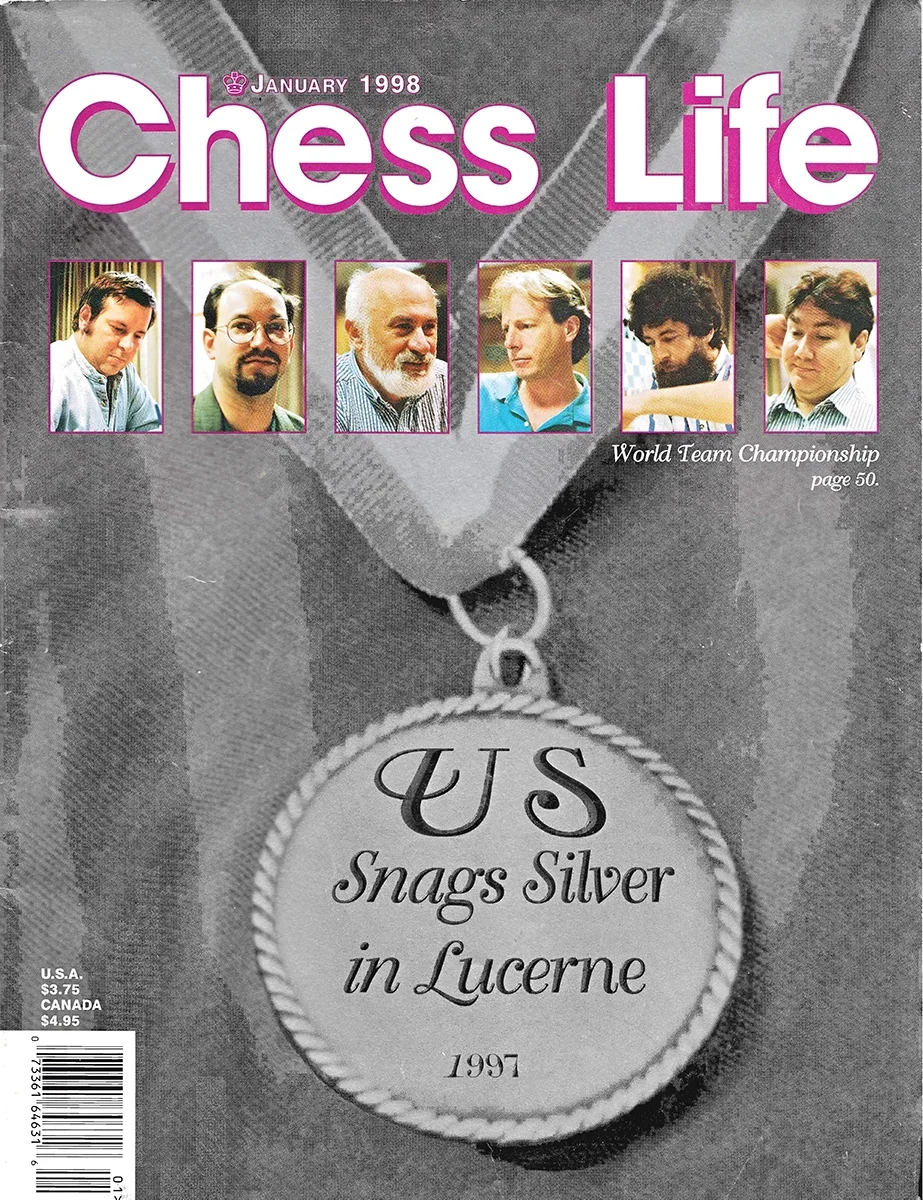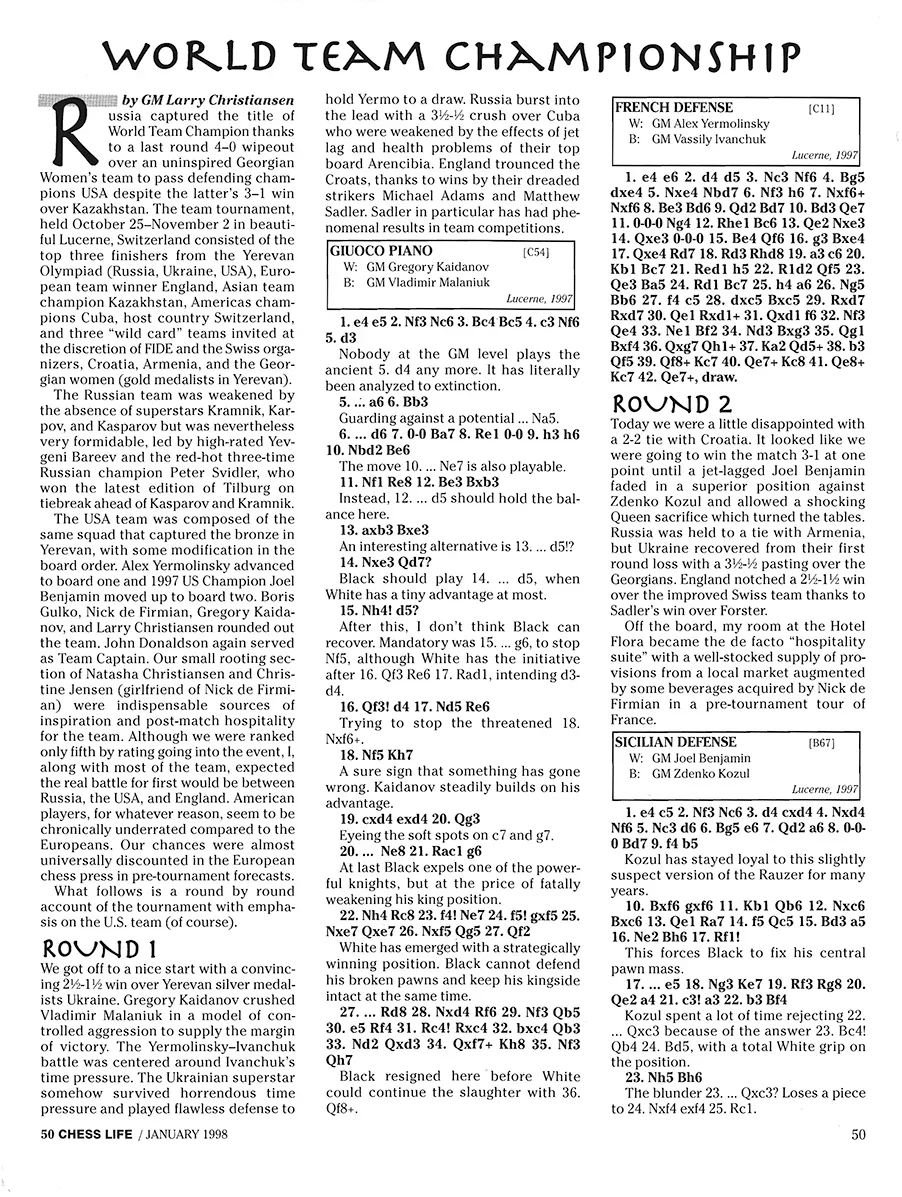The first World Team Chess Championship was held in Lucerne, Switzerland in November 1985. The U.S. team qualified to play in the Open section but did not attend, and was replaced by a team from France. There was no Women’s section at these first incarnations of the event, and this oversight was only remedied in 2007.
The U.S. has medalled three times in the World Teams. The Open team won Silver in both 1997 and 2009, and Gold in 1993. Today we revisit the 1997 event, also held in Lucerne, and our Throwback is drawn from Larry Christiansen’s report in the January 1998 issue of Chess Life.
The 1997 team was identical to the Bronze medal winning team from the 1996 Yerevan Olympiad, although the board order changed.
 Individual medals:
Yermolinsky won bronze on Board One, Kaidanov took gold as 1st Reserve, and Christiansen won silver for his performance as 2nd Reserve.
Individual medals:
Yermolinsky won bronze on Board One, Kaidanov took gold as 1st Reserve, and Christiansen won silver for his performance as 2nd Reserve.
In what follows we present three games from the tournament with Christiansen’s analysis. Game 1 Our first game features a nice win in the Giuoco Piano by GM Gregory Kaidanov, who is currently playing in the Spring Classic B Section at the Saint Louis Chess Club. Played in Round 1, when the U.S. defeated the Ukraine team by a score of 2.5-1.5, Christiansen writes that “Kaidanov crushed Vladimir Malaniuk in a model of controlled aggression to supply the margin of victory.”
- Alex Yermolinsky
- Joel Benjamin
- Boris Gulko
- Nick de Firmian
- Gregory Kaidanov
- Larry Christiansen
 Individual medals:
Yermolinsky won bronze on Board One, Kaidanov took gold as 1st Reserve, and Christiansen won silver for his performance as 2nd Reserve.
Individual medals:
Yermolinsky won bronze on Board One, Kaidanov took gold as 1st Reserve, and Christiansen won silver for his performance as 2nd Reserve.
In what follows we present three games from the tournament with Christiansen’s analysis. Game 1 Our first game features a nice win in the Giuoco Piano by GM Gregory Kaidanov, who is currently playing in the Spring Classic B Section at the Saint Louis Chess Club. Played in Round 1, when the U.S. defeated the Ukraine team by a score of 2.5-1.5, Christiansen writes that “Kaidanov crushed Vladimir Malaniuk in a model of controlled aggression to supply the margin of victory.”
[pgn]
[Event "WchT 4th"]
[Site "Luzern"]
[Date "1997.10.25"]
[White "Kaidanov, Gregory S"]
[Black "Malaniuk, Vladimir P"]
[Result "1-0"]
[ECO "C54"]
[WhiteElo "2600"]
[BlackElo "2615"]
[Annotator "Christiansen"]
[PlyCount "70"]
1. e4 e5 2. Nf3 Nc6 3. Bc4 Bc5 4. c3 Nf6 5. d3 {Nobody at the GM level plays
the ancient 5.d4 any more. It has literally been analyzed to extinction.} a6 6.
Bb3 {Guarding against a potential ... Na5.} d6 7. O-O Ba7 8. Re1 O-O 9. h3 h6
10. Nbd2 Be6 ({The move} 10... Ne7 {is also playable.}) 11. Nf1 Re8 12. Be3
Bxb3 ({Instead} 12... d5 {should hold the balance here.}) 13. axb3 Bxe3 ({
An interesting alternative is} 13... d5 $5 {.}) 14. Nxe3 Qd7 $2 ({White should
play} 14... d5 {, when White has a tiny advantage at most.}) 15. Nh4 $1 d5 $2 {
After this, I don't think Black can recover.} ({Mandatory was} 15... g6 {
, to stop Nf5, although White has the initiative after} 16. Qf3 Re6 17. Rad1 {
, intending d3-d4.}) 16. Qf3 $1 d4 17. Nd5 Re6 {Trying to stop the threatened
18.Nxf6+.} 18. Nf5 Kh7 {A sure sign that somethign has gone wrong. Kaidanov
steadily builds on his advantage.} 19. cxd4 exd4 20. Qg3 {Eying the soft spots
on c7 and g7.} Ne8 21. Rac1 g6 {At last Black expels one of the powerful
knights, but at the price of fatally weakening his king position.} 22. Nh4 Rc8
23. f4 $1 Ne7 24. f5 $1 gxf5 25. Nxe7 Qxe7 26. Nxf5 Qg5 27. Qf2 {White has
emerged with a strategically winning position. Black cannot defend his broken
pawns and keep his kingside intact at the same time.} Rd8 28. Nxd4 Rf6 29. Nf3
Qb5 30. e5 Rf4 31. Rc4 $1 Rxc4 32. bxc4 Qb3 33. Nd2 Qxd3 34. Qxf7+ Kh8 35. Nf3
Qh7 {Black resigned here before White could continue the slaughter with 36.
Qf8+.} 1-0
[/pgn]
Game 2
GM Joel Benjamin lost a fascinating game in Round 2 when GM Zdenko Kozul took advantage of a Benjamin mistake, and took control of the game with a powerful Queen sac. This variation of the Richter-Rauzer, famously dubbed the “Kozul suicide variation” by Yermolinsky for its no-holds-barred, burn every last bridge approach, is currently topical. Kozul himself has published a book on the topic in recent years, and a downloadable database product on the variation from IM Ogulcan Kanmazalp at modern-chess.com is just out.
[pgn]
[Event "WchT 4th"]
[Site "Luzern"]
[Date "1997.10.26"]
[White "Benjamin, Joel"]
[Black "Kozul, Zdenko"]
[Result "0-1"]
[ECO "B67"]
[WhiteElo "2580"]
[BlackElo "2605"]
[Annotator "Christiansen"]
[PlyCount "76"]
1. e4 c5 2. Nf3 Nc6 3. d4 cxd4 4. Nxd4 Nf6 5. Nc3 d6 6. Bg5 e6 7. Qd2 a6 8.
O-O-O Bd7 9. f4 b5 {Kozul has stayed loyal to this slightly suspect version of
the Rauzer for many years.} 10. Bxf6 gxf6 11. Kb1 Qb6 12. Nxc6 Bxc6 13. Qe1 Ra7
14. f5 Qc5 15. Bd3 a5 16. Ne2 Bh6 17. Rf1 $1 {This forces Black to fix his
central pawn mass.} e5 18. Ng3 Ke7 19. Rf3 Rg8 20. Qe2 a4 21. c3 $1 a3 22. b3
Bf4 ({Kozul spent a lot of time rejecting} 22... Qxc3 {because of the answer}
23. Bc4 $1 Qb4 24. Bd5 {, with a total White grip on the position.}) 23. Nh5
Bh6 ({The blunder} 23... Qxc3 $2 {loses a piece to} 24. Nxf4 exf4 25. Rc1) 24.
Bc2 Rc7 25. Rh3 Bg5 26. Rhd3 Rgc8 27. Qe1 $1 Ba8 28. h4 Bh6 {[#]} 29. g4 $6 ({
Joel missed the breathtakingly beautiful shot} 29. b4 $3 Qc4 30. Nxf6 $3 Kxf6
31. Rxd6+ Ke7 32. f6+ (32. Rxh6 $2 {is good for Black} Qxc3) 32... Ke8 33. Qg3
$1 Qxc3 (33... Bf8 34. Qxe5+) 34. Qg8+ Bf8 35. Qxf8+ $1 Kxf8 36. Rd8+ Rxd8 37.
Rxd8#) 29... Bf4 $1 30. Qe2 {White still has a nice grip on the position, but
he must be careful.} h6 31. Qf3 $4 {[#]} ({The move} 31. Rf1 {keeps the
advantage. Now Kozul, down to his final minute or so, seizes his chance.})
31... Qxc3 $1 32. Rxc3 Rxc3 33. Qf1 ({The alternative} 33. Qe2 Rxc2 34. Qxc2
Rxc2 35. Kxc2 Bxe4+ 36. Kc3 Be3 37. Ng3 Bf3 38. Rd3 d5 $1 {is winning for
Black.}) 33... Rxc2 34. Nxf4 Rb2+ 35. Ka1 Rcc2 {Amazingly, White is in a
mating net.} 36. Nd3 Rxa2+ 37. Kb1 Bxe4 38. Qg1 Rcb2+ 0-1
[/pgn]
Game 3
The background of this game - a hard-fought, workman-like victory by Christiansen - is important for context. The U.S entered the ninth and final round tied for first place with Russia, but a suspicious 4-0 Russian victory over the Georgian team meant that the U.S. had no margin for error. After Joel Benjamin, playing on Board One, was forced to take an early draw after an unambitious opening by his Kazakh opponent, Christiansen could play with a bit of unwanted freedom.
[pgn]
[Event "WchT 4th"]
[Site "Luzern"]
[Date "1997.11.02"]
[White "Christiansen, Larry Mark"]
[Black "Temirbayev, Serikbay"]
[Result "1-0"]
[ECO "E82"]
[WhiteElo "2550"]
[BlackElo "2475"]
[Annotator "Christiansen"]
[PlyCount "83"]
1. d4 ({I had been playing} 1. e4 {throughout, but I knew opponent's case
history through the computer data base and was happy to see that the played a
second-rate line against the Saemisch.}) 1... Nf6 2. c4 g6 3. Nc3 Bg7 4. e4 d6
5. f3 O-O 6. Be3 a6 7. Bd3 b6 8. Nge2 c5 9. e5 Nfd7 ({Better than the old} 9...
Ne8 10. Be4 Ra7 11. dxc5 bxc5 12. Bxc5 Rd7 13. Be3 {with an enduring plus for
White.}) 10. exd6 exd6 11. O-O Nc6 12. Be4 Bb7 13. Qd2 Nf6 14. Bxc6 Bxc6 15.
Rad1 ({The try} 15. Bh6 {was also good when White may later try to challenge
the e-file.}) 15... Re8 16. Bh6 b5 17. Bxg7 Kxg7 18. Ng3 bxc4 19. dxc5 d5 ({Not
} 19... dxc5 $2 {, when} 20. Nf5+ {wins.}) 20. Qg5 $2 ({My original intention
was} 20. Nce4 {, but Black is okay after} Nxe4 (20... dxe4 {is answered
strongly by} 21. Nf5+ $1) 21. fxe4 Re5 $1 {and White cannot cash in.} (21... d4
{is met by} 22. Qf2)) ({Best is the logical centralizing and pinning move} 20.
Qd4 {, with a slight edge to White.}) 20... Qc8 $1 21. Rd4 $2 ({Better was} 21.
h4) ({or} 21. Rf2 {with possibly a little something.}) 21... h6 $1 22. Qd2 Qe6
23. b4 $2 {Creating a big weakness on the queenside.} (23. Nge2 {was correct
with equal play.}) 23... cxb3 24. axb3 a5 $1 25. Nge2 Rab8 26. Rb1 {Ugh.} Qe7 {
[#] I was pretty disgusted with myself at this point. How could I do this to
my position? I realized now that in virtually every scenario I must lose not
only the c-pawn but also the b-pawn as well. It was around here that John
Donaldson advised me to "keep a stable position" during a coffee run. Alas, I
had already destabilized my position.} 27. Rh4 $6 {A bad idea, but give me
credit for trying.} Qxc5+ 28. Nd4 g5 29. Rxh6 {I didn't actually see the
refutation of this, but I had little choice in the matter at this stage.} Kxh6
30. Rc1 Rb4 $4 ({Instead,} 30... Bd7 {should do the trick, when on} 31. h4 Kh7
32. hxg5 Ng8 {, despite some discomfort, Black is a whole rook up.}) 31. Ncb5
$1 Rxb5 ({After the game some GMs suggested} 31... Re2 {, which I confess to
completely overlooking. But actually then it seems White can draw with} 32. Qd1
$1 Rxd4 33. Nxd4 Re1+ 34. Qxe1 Qxd4+ 35. Qf2 $1 Qxf2+ 36. Kxf2 Bd7 37. Ra1 {
, winning the a-pawn and setting up a blockade on d4.}) 32. Rxc5 Rxc5 33. h4
Re5 $1 34. hxg5+ {We were both in time pressure at this point.} Rxg5 35. Nf5+
Kh5 36. Qf4 d4 $1 37. Ne7 $1 Ng4 $2 (37... Rg6 $1 {offers drawing chances.})
38. fxg4+ Rxg4 39. Qxf7+ Kg5 40. Qg6+ Kf4 41. Qd6+ Ke3 42. Qxc5 {White's king
escaped Black's checks by running to the queenside.} 1-0
[/pgn]
All of these games and their annotations are presented as published in the magazine, and without computer corrections. There are corrections to be found, of course, but readers might take it upon themselves this week to locate them without silicon assistance. Trying to find holes in published analysis is an excellent way to hone one’s analytical skills. It’s also fun!
Categories
Archives
- December 2025 (19)
- November 2025 (29)
- October 2025 (39)
- September 2025 (27)
- August 2025 (29)
- July 2025 (43)
- June 2025 (25)
- May 2025 (24)
- April 2025 (29)
- March 2025 (29)
- February 2025 (20)
- January 2025 (24)
- December 2024 (34)
- November 2024 (18)
- October 2024 (35)
- September 2024 (23)
- August 2024 (27)
- July 2024 (44)
- June 2024 (27)
- May 2024 (31)
- April 2024 (51)
- March 2024 (34)
- February 2024 (25)
- January 2024 (26)
- December 2023 (29)
- November 2023 (26)
- October 2023 (37)
- September 2023 (27)
- August 2023 (37)
- July 2023 (47)
- June 2023 (33)
- May 2023 (37)
- April 2023 (45)
- March 2023 (37)
- February 2023 (28)
- January 2023 (31)
- December 2022 (23)
- November 2022 (32)
- October 2022 (31)
- September 2022 (19)
- August 2022 (39)
- July 2022 (32)
- June 2022 (35)
- May 2022 (21)
- April 2022 (31)
- March 2022 (33)
- February 2022 (21)
- January 2022 (27)
- December 2021 (36)
- November 2021 (34)
- October 2021 (25)
- September 2021 (25)
- August 2021 (41)
- July 2021 (36)
- June 2021 (29)
- May 2021 (29)
- April 2021 (31)
- March 2021 (33)
- February 2021 (28)
- January 2021 (29)
- December 2020 (38)
- November 2020 (40)
- October 2020 (41)
- September 2020 (35)
- August 2020 (38)
- July 2020 (36)
- June 2020 (46)
- May 2020 (42)
- April 2020 (37)
- March 2020 (60)
- February 2020 (38)
- January 2020 (45)
- December 2019 (34)
- November 2019 (35)
- October 2019 (42)
- September 2019 (45)
- August 2019 (56)
- July 2019 (44)
- June 2019 (35)
- May 2019 (40)
- April 2019 (48)
- March 2019 (61)
- February 2019 (39)
- January 2019 (30)
- December 2018 (29)
- November 2018 (51)
- October 2018 (45)
- September 2018 (29)
- August 2018 (49)
- July 2018 (35)
- June 2018 (31)
- May 2018 (39)
- April 2018 (31)
- March 2018 (26)
- February 2018 (33)
- January 2018 (30)
- December 2017 (26)
- November 2017 (24)
- October 2017 (30)
- September 2017 (30)
- August 2017 (31)
- July 2017 (28)
- June 2017 (32)
- May 2017 (26)
- April 2017 (37)
- March 2017 (28)
- February 2017 (30)
- January 2017 (27)
- December 2016 (29)
- November 2016 (24)
- October 2016 (32)
- September 2016 (31)
- August 2016 (27)
- July 2016 (24)
- June 2016 (26)
- May 2016 (19)
- April 2016 (30)
- March 2016 (36)
- February 2016 (28)
- January 2016 (32)
- December 2015 (26)
- November 2015 (23)
- October 2015 (16)
- September 2015 (28)
- August 2015 (28)
- July 2015 (6)
- June 2015 (1)
- May 2015 (2)
- April 2015 (1)
- February 2015 (3)
- January 2015 (1)
- December 2014 (1)
- July 2010 (1)
- October 1991 (1)
- August 1989 (1)
- January 1988 (1)
- December 1983 (1)









